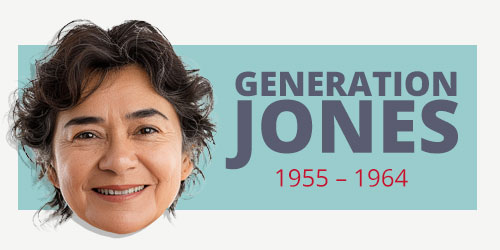
Not All Baby Boomers Are Created Equal
We’ve all heard the statistics about baby boomers — those individuals who were born between 1946 and 1964.
They are the second-largest population segment in the U.S. today (the millennial generation is the largest), and they hold the most buying power.
The 18-year age span is quite large, and it begs the question “Are all baby boomers the same economically, socially and culturally?”
Jonathan Pontell, a culture commentator, says all baby boomers are not alike. He breaks them down into two distinctly separate segments — Early Boomers and Generation Jones.
Let’s take a look at how these two baby boomer segments differ.

Early Boomers were born between 1946 and 1954. Today there are 33 million of them in America.
This segment was influenced culturally and socially by events that included the Vietnam War (“Give Peace a Chance”), Woodstock and folk music (the Bob Dylan Generation), and the oil crisis.
They are optimistic, idealistic, individualistic, free-spirited, experimental and cause-oriented.
They grew up during an era where trust was built over time, and once earned it was hard to shake. This is why they are loyal to brands that have stood the test of time. They connect with brands that consistently deliver on quality, reliability and authenticity.

Baby boomers in this segment were born between 1955 and 1964 and number 39 million, larger than their early boomer counterparts.
They are referred to as the Generation Jones because they crave what older Early Boomers have. They want to be recognized and heard.
This segment was influenced culturally and socially by events that included Watergate, “Just Say No” to drugs, and Reaganomics that created a tight labor market because of the shift from a manufacturing to a service economy. 401Ks have replaced company-paid pensions as a way for them to build toward retirement. They tend to have smaller families because of the need to have two wage earners in the household. This has led to a change in the traditional family environment.
They are quite different than their Early Boomer counterparts in terms of attitudes. They are highly competitive, more practical and rational, more pessimistic, and generally more cynical. They are more likely to distrust the government and less likely to affiliate with one political party; they are often what are known as the “swing voters” in elections.
This group is financially influential, representing $70 trillion in household wealth. However, as consumers, they are not as brand loyal as the Early Boomers.
This may account for why Generation Jones is undertargeted by marketers. Indeed, according to a Nielsen study, only 10% to 15% of advertising dollars are spent on this demographic despite their accounting for almost half of consumer package goods sales.
Three ways to differentiate your marketing appeals between Early Boomers and Generation Jones:
1. Make the right emotional appeals.
Early Boomers may respond well to communications that emphasize family values and community. Generation Jones, however, will likely respond better to appeals to their sense of individuality and self-expression and to messages that use humor and irony.
2. Provide the right kind of information.
Generation Jones boomers like to make their own decisions about which products and services to buy. They’re also turned off by hard-sell tactics and hype. So just give them product facts and attributes straight up.
Early Boomers look for some affirmation from others to give them confidence that a product or service will meet their needs. Providing them with product reviews and customer testimonials really helps.
3. Use nostalgia in the right ways.
Like Early Boomers, Generation Jones boomers respond well to nostalgia. But be sure to draw from the mid-70s and early 80s and not from the Summer of Love when appealing to Jonesers. Most of them were in grade school when Early Boomers were at Woodstock.
The key takeaway
Not all baby boomers are alike. In fact, Early Boomers and Generation Jones are quite different. So you must use differentiated marketing communications with appeals that are tailored to each segment’s distinct characteristics, preferences and behaviors.
If you don’t, your message will likely go unheard and your product or service will go unsold.
To learn more about the differences between Early Boomers and Generation Jones and how GKV can help you gain traction with both, contact Garry Raim at garry.raim@gkv.com.

